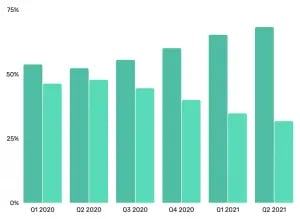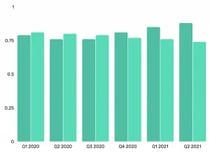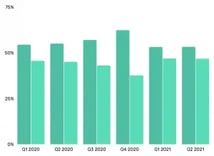Internet by numbers: How customer experience impacts an ISP’s market share

For an internet service provider (ISP), customer satisfaction is a big deal. How happy your customers are is the difference between successful retention and painful attrition. And that happiness level depends entirely on your customer experience.
As much as it relates to current customer numbers, though, customer experience can affect your ISP’s ability to take over more of a market, too. Recently, we examined our in-house data to see exactly how a high-quality experience—specifically within the customer’s home—can influence an ISP’s ability to increase market share.
To show you what we discovered, let’s take a look at two very different cities.
Quick note: The quality metrics we’re looking at here are based on standard scores, where points are subtracted for each report of a related issue.
City study: San Diego
First off, let’s take a look at San Diego, California. Between Q1 2020 and Q2 2021, we saw one ISP rocket up from 40% market share to over 60%. That’s a big leap—and it happened pretty quickly, too.
To add a bit of context, this ISP is a large player. With 20,000 employees across the U.S., it operates in multiple states and has an established foothold in its markets. This is particularly interesting because as an established company, it takes a lot more for any shift to happen, let alone one of over 20%.
Here’s a quick look at the trend in overall market share between this ISP and its main competitor:


There are two components to this trend: Network quality, and in-home experience. Interestingly, our sample ISP did some improvements to its network before our sample period, which certainly could have contributed to the increase in market share. But there was enough of a gap in the timing that it isn’t directly related.
Instead, we noticed that this market share trend and its timing correlated directly with a reported improvement to the ISP’s in-home experience.
City study: New York City
Obviously, data is no good if you only look at one sample. So we decided to examine a completely different market to see if there was a similar trend. New York City told us a slightly different story, but it still showcased how in-home experience impacts market share.
For this study, we looked at two of the larger ISPs in the city. It wasn’t a one-sided pattern like we saw in San Diego; instead, this data shows more of a tug of war.

Throughout Q1 2020 up until about Q4 2020, you can see that one ISP steadily gained market share. Then, around the end of Q4 2020/start of Q1 2021, its competitor put up a big fight.
When we looked closer, it became clear that this shift correlated to a boost in the second ISP’s network quality, which could mean that improvements to infrastructure helped attract new customers.
Then, however, you see the first ISP start to push back, and even regain ground lost in Q2 2021. This correlates directly with an increase in the ISP’s in-home experience—and it’s significant because it suggests that even in the face of infrastructure improvements, in-home experience may be more important to customers.
The impact of in-home experience on market share
As we’ve seen in these two cities, the in-home experience your customers have with you has a major impact on your ISP’s ability to take and hold market share. By delivering a better experience, your ISP can attract more customers, retain existing ones, and build your company’s bottom line.
